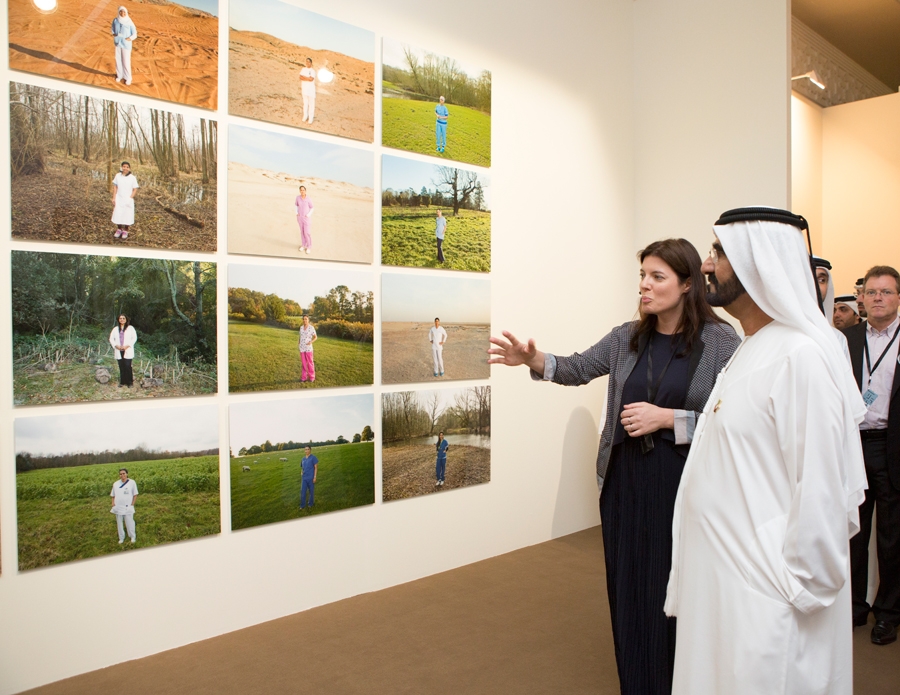Driving at 120kph on the six-lane Sheikh Zayed freeway through Dubai, calmly tailgating, my taxi driver, a Bangladeshi, tells me he’s been in Dubai for seven years. He has family back at home, a wife, two kids. He makes decent money driving a taxi, by Bangladeshi standards. I explain that I’m here once more for the Art Dubai art fair; yes, he says, it’s getting busier this time of year, business is good, but things are getting more expensive. Rents are going up, he complains, particularly since the UAE won the bidding to host Expo 2020 in Dubai, last November.
‘World Expo’, burbles the Expo 2020 website, ‘is a catalyst for economic, cultural and social transformation and generates important legacies for the host city and nation.’ Here in Dubai, I’m wondering what kind of catalyst art might be for this dusty, busy Emirate city-state. Without a doubt there’s a sort of art scene growing up here. Commercial galleries are developing, and there are one or two nonprofit initiatives. Art Dubai is growing in confidence, along with its sister fair Design Days Dubai and the city-sponsored Sikka emerging-art fair.
These developments of the cultural scene are a government-sanctioned project, part of a systematic attempt by Dubai to transform itself into a hub for finance, trade and expatriate high-living
Effectively, though, these developments of the cultural scene are a government-sanctioned project, part of a systematic attempt by Dubai to transform itself into a hub for finance, trade and expatriate high-living. Art Dubai and its other initiatives are co-owned by the DIFC, Dubai’s financial free zone. ‘DIFC has been designed to live up to the expectations of the elite, and strikes the perfect balance between retail, commercial and residential space. Work and play, day and night, the district enhances people’s lifestyles,’ declares the DIFC’s mission statement. Buildingsite hoardings advertise endless vistas of luxury villa living…
Contemporary art, then, is part of the ‘offer’, and it’s striking how readily art is generated to fill such a context. What’s remarkable – and unnerving – about the invention of an art scene, almost from scratch, in a place like Dubai, is how it bears witness to the expansion of the idea of the ‘contemporary’ as a globally transplantable cultural form, virally reduplicated as a functional part of any self-respecting, modernising, social elite’s image of itself, of how it behaves and how it wants to spend its leisure time and wealth. There may be good art, bad art and indifferent art on show and on sale at Art Dubai, and it is of course interesting to discover artists and works that haven’t yet established their reputations further west. The visual ‘language’ and conventions of contemporary art are present and operating smoothly. But this very seamlessness and smoothness brings me to consider how contemporary art now relates to its ‘outside’ – to the society in which it operates.
If you don’t have a job, if you’re not sponsored, you don’t stay, whether you’re the white Western expat or the taxi driver from Bangladesh
‘Outside’, in a place like Dubai, is a strange place. It’s a place where few have the right to remain, other than the Emiratis themselves, and where everyone else comes and goes, stays for a few years, works, makes money, leaves. If you don’t have a job, if you’re not sponsored, you don’t stay, whether you’re the white Western expat or the taxi driver from Bangladesh. There are strange exceptions, like the young artist I talk to on the drinks terrace who is the fourth generation of his family to live in Dubai without proper citizenship, caught in the various paradoxes of exile and emigration – where others can’t stay in Dubai, he can’t leave, as he’d never be let back in to the country he grew up in.
If contemporary art is Western in origin, then its cultures, discourses and institutions evolved spontaneously, organically, in the historical emergence of the public sphere, in the battles for democracy and free expression, for what it meant to be part of a public and what it meant, as an artist, to address a public, all the while deliberating what art’s role in a society was meant to be. In the world after globalisation, though, it’s as if this Western phenomenon has been carefully emptied of that history, surgically disconnected from its ties to a living, conflicted social reality, to become an infinitely reduplicable module that can be plugged into the topdown development of the new ‘global city’, where art is no more than a form of lifestyle choice, and in which it is largely indifferent – necessarily so – to the society it inhabits.
As the US-based Global Cultural Districts Network argues, the arts have ‘played a major role in defining the identity of established global capitals like London, New York, Berlin, and Paris, but many of the entertainment and arts districts in which they are located have developed organically, often over the course of several centuries, and without formal investment strategies. Today, cultural infrastructure is increasingly planned large-scale and top down.’ And why is that? Because ‘globalization has led to competition between cities and regions for inward investment, knowledge workers, and tourists. Large-scale cultural projects are now an increasingly important driver of competitiveness and are key in branding and differentiating regions and cities.’ Once modern art was hated by the system it challenged from outside. Contemporary art, it seems, is now both the system’s driver, and its brand.
This article was first published in the May 2014 issue.
